Social Media SEO in 2024: How to Get Discovered on Social Media (And Beyond)

Search engine optimization (SEO) sounds like a fancy jargon word that has a suit with elbow patches on. But it’s really just a way to be easily visible and discoverable to your target audience.
In this article, I’ll explain what SEO is for social media, why you should care about it, and how you can use it to your advantage.
What is social media SEO?
Social media SEO involves using search engine optimization tactics in your social media posts so that more people click on them when they search for relevant keywords.
Let’s say you want to search for the best restaurants in Amsterdam for your travel plans. You can go to Instagram, Pinterest, YouTube, or any other social media platform to find creator recommendations.

The above is a classic example of how people use social media SEO to find answers to their search queries. The questions range from travel and product recommendations to full-fledged tutorials.
Social media SEO has three aspects:
- Improving your brand’s visibility using your social media profiles on search engines like Google and Bing. This is especially true for branded keywords like your brand’s name. For example, when you search for Curlsmith on Google, its Instagram account, YouTube channel, and Facebook Page also appear on the first page of results.
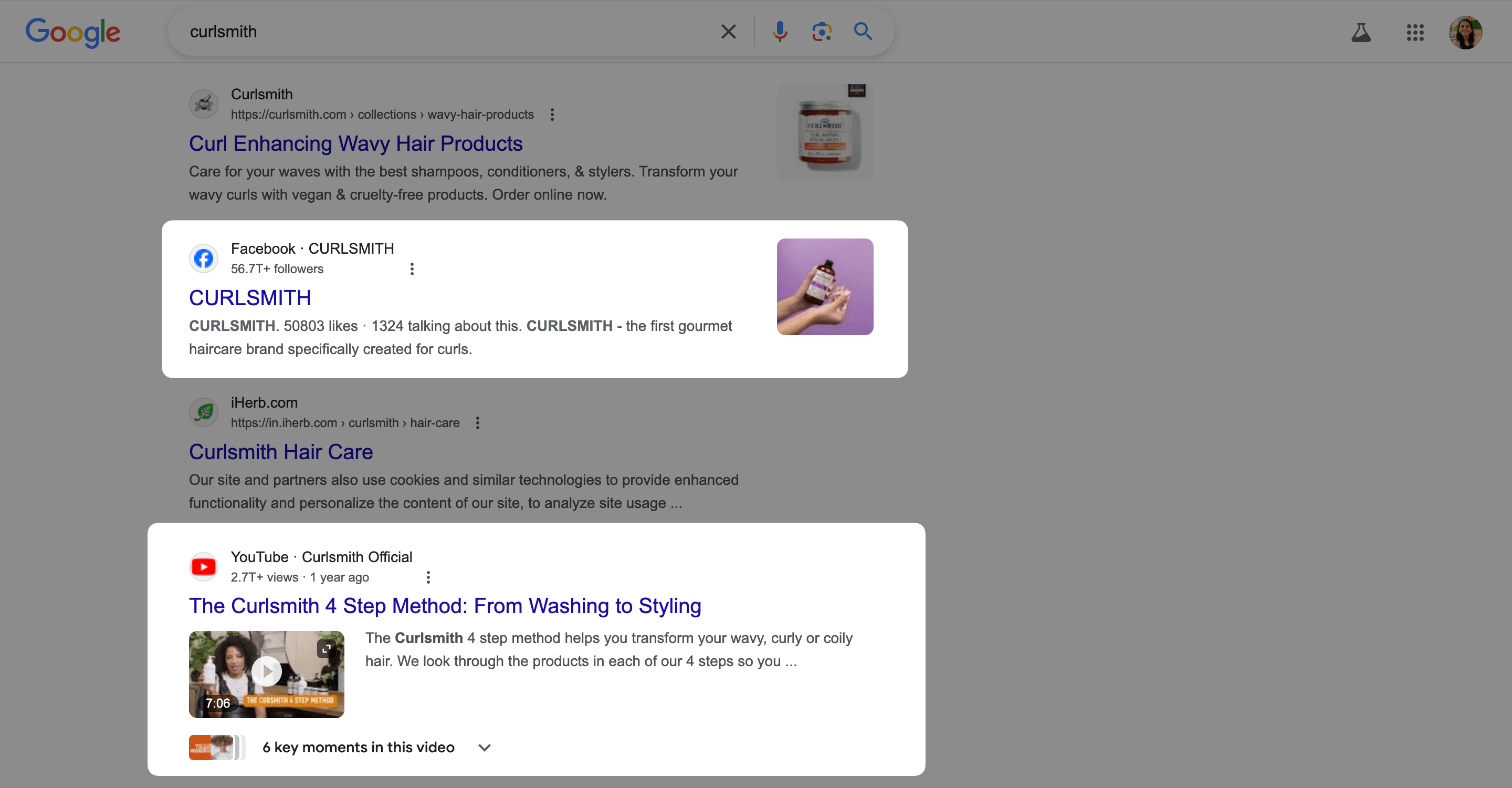
- Improving the visibility of your individual social media posts for the social media platforms’ search engines. Each social media network has a search bar — although it’s not as advanced as the search engines of Google, Bing, Tor, etc. Optimizing your social media content with relevant keywords ensures that your posts appear at the top when your target audience searches for their questions. For example, Curlsmith’s video comes up in the top ten results when I search for “how to refresh curls in five minutes” on YouTube.
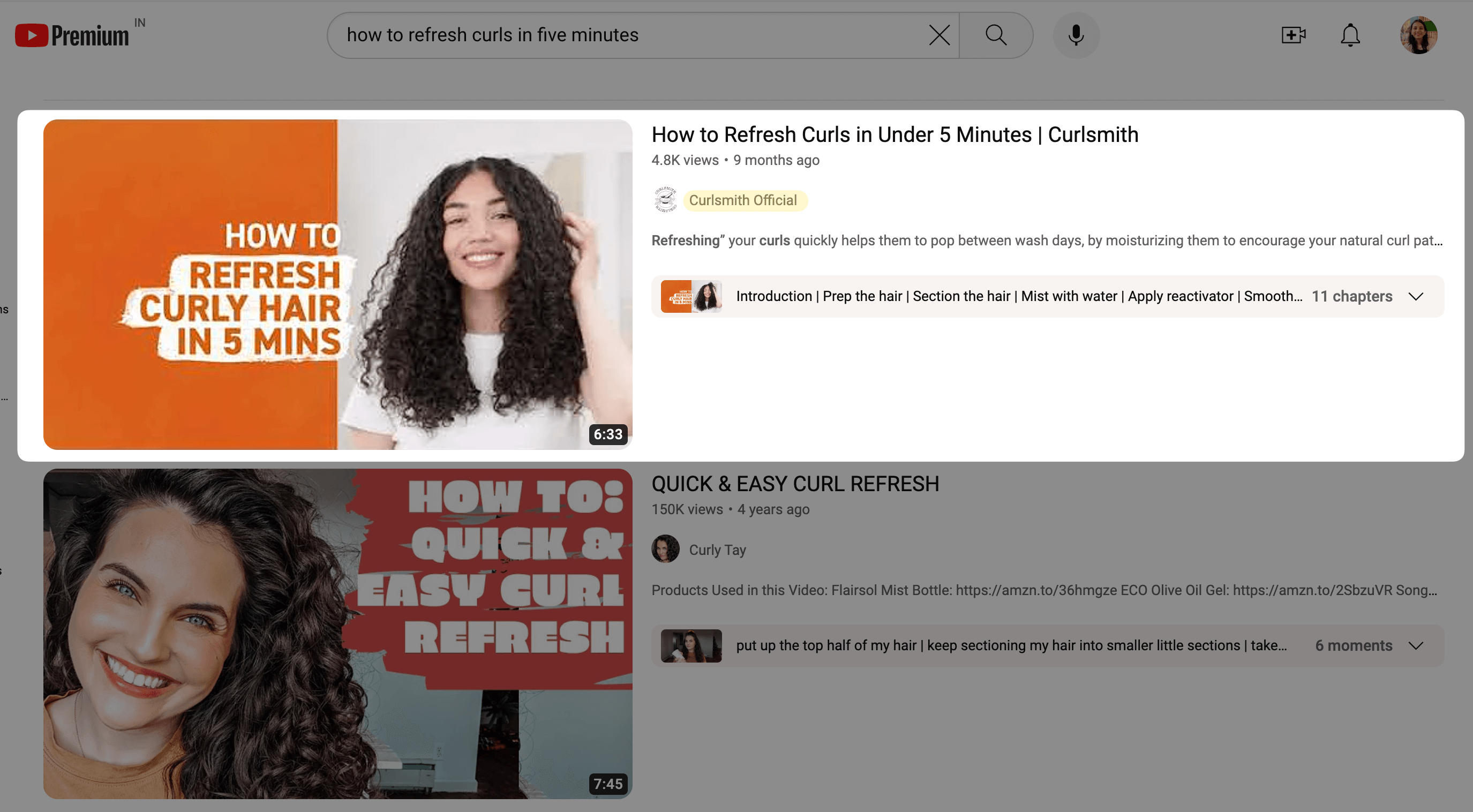
- Using social SEO will drive traffic to your website. Search engines typically don’t use social signals to impact the ranking of your website. This means social media SEO doesn’t directly impact your rankings in platforms like Google (it does in Bing, though). But you can use social SEO to increase traffic by redirecting your audience on social to your website by repurposing your content for social media. For example, if I search for “curly hair gel cast” on Pinterest, one of the top posts by creator Delilah Orpi redirects the users to her blog on the topic.
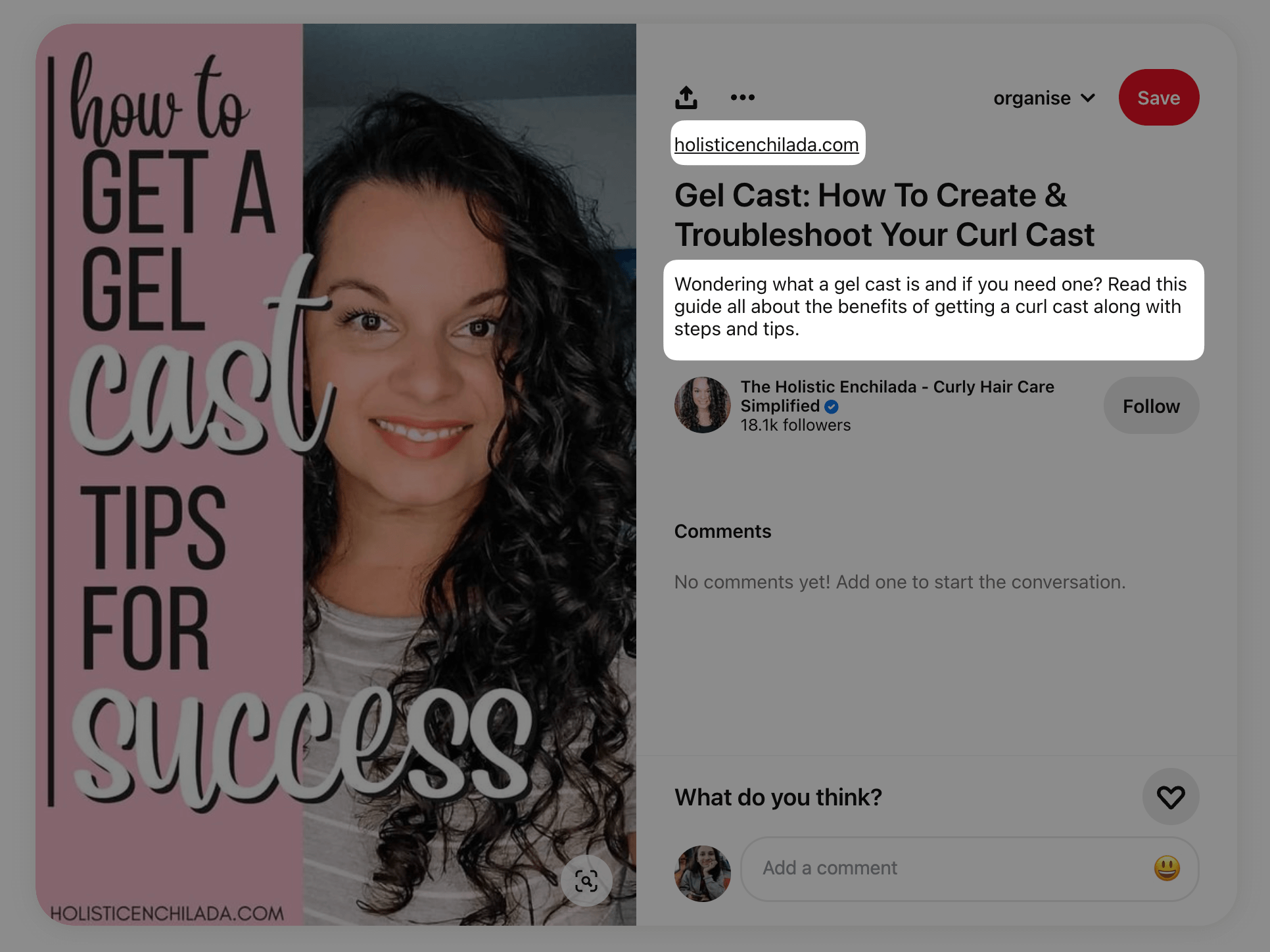
These three facets collectively form what we call social media SEO. To nail search engine optimization for social media, it’s best to work on all three elements in tandem. More on how to do that and form your social media SEO strategy in the next section.
How is social SEO different from social media algorithms?
The goal for social SEO and social algorithms is common: Improving your social content’s visibility.
But social media SEO is all about improving the visibility of your social content using relevant keywords, alt-text, and more. You want your posts to appear on top when someone searches for your keywords in your niche.
On the other hand, social media algorithms are all about trying to improve your visibility via the rules and formulas that govern the respective social media platforms. You want to appear on their For You or Recommended pages.
Let’s say you’re a travel creator and someone searches for “best places to visit in Italy” on TikTok. You want your video to appear at the top to ace social media SEO. But you also want to appear in relevant users’ (who are interested in travel) feeds automatically when they’re browsing through their For You page.
There’s a different process to achieve success in social SEO versus social media algorithms (albeit with some overlap):
- Whether or not your posts appear at the top for relevant search queries depends on factors like using the right keywords, having a strong niche, etc.
- Whether or not your posts appear on someone’s For You page depends on multiple (and some out-of-your-control) factors — such as trending topics, consistent publishing, and a host of other things.
I’ll admit there’s some convergence between the two concepts. Focusing on making your social content SEO-friendly can also translate to a blessing from the algorithmic Gods. This is because some SEO practices (like having a solid niche) also work in favor of getting the green light from algorithms.
For example, if you have a strong grasp of TikTok SEO, you’ll likely use relevant and trending hashtags to categorize your posts. This also works positively for acing the TikTok algorithm because it values engagement and a tight niche post and account.
Should you optimize your social media content for SEO?
Google is no longer the only place people search for answers to their questions. According to one study, almost 40 percent of young people (aged 18–24) in the U.S. said they use TikTok or Instagram to find places for lunch instead of Maps or Google search.
Another more recent study found social media is the number one channel for Gen Z, millennials, and Gen X to discover new products. Moreover, 31 percent of respondents search for answers to their questions on social media.
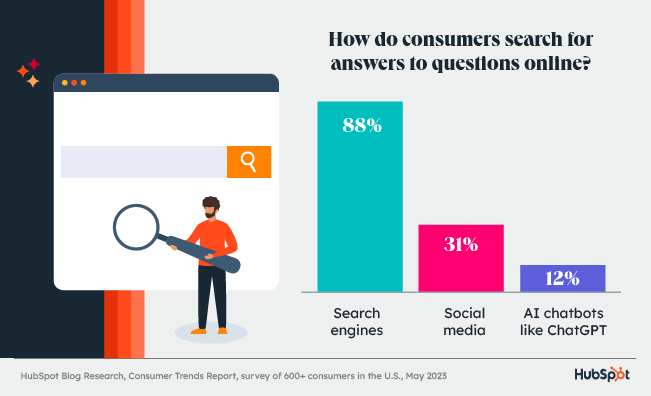
And that’s not all: Google has been referencing more & more forum-based social results (like Reddit) in SERP results after its latest update. In their own words:
“In the coming weeks, when you search for something that might benefit from the experiences of others, you may see a Perspectives filter appear at the top of search results. Tap the filter, and you’ll exclusively see long- and short-form videos, images and written posts that people have shared on discussion boards, Q&A sites and social media platforms. We’ll also show more details about the creators of this content, such as their name, profile photo or information about the popularity of their content.”
Investing in social SEO can boost your brand’s visibility, help you get more targeted engagement, build trust among your audience, and attract a wider audience. The top social media sites are also working to make their search engines smarter, like how TikTok expanded the video captions to 2,200 characters (from the previous 300) or how Pinterest encourages using the right keywords to affect your content distribution positively.
How is social media SEO different from traditional SEO?
For starters, social SEO isn’t as complicated as traditional SEO (yet). Phew! Here are three other differences between social SEO and traditional SEO:
1. Content types: Content in SERPs is mostly long-form written content (like this article). Videos on YouTube also often appear in search engines like Google. But, social SEO only shows the platform’s content types — which is visual content like images or videos.
2. Measuring engagement for ranking: Traditional SEO looks at things like backlinks, bounce rate, domain rating, site speed, etc., to rank a website. Social SEO uses metrics like likes, comments, shares, social referral traffic, etc., within social media platforms to rank social content.
3. Time sensitivity: Social media is much more fast-paced than traditional SEO. Trending topics might get virality in social media content and climb the rankings within social networks. But this is volatile because the trends change rapidly. Traditional SEO content is more evergreen; its primary focus is creating content that stays fresh for an extended period.
Do social signals matter in improving your website’s ranking in SERP?
The full form of SERP is “search engine results pages” — the pages that appear when you search for something on a search engine. You want your website to appear on the first page for maximum visibility.
But Google doesn’t take social signals into account when ranking websites. This means your repurposed post can go viral on social media and drive little to no traffic from Google. It isn’t a ranking factor. Google will use your social media account’s info to verify your business is legitimate, but that’s pretty much it.
But that doesn’t mean social SEO has no impact on your organic traffic. Social media posts can amplify your site content. For example, your post might not rank on the first page of Google but garner engagement via social media. So, your website will have visitors coming in through a different source (social media instead of SERP).
Social media can also help you get valuable backlinks that improve your website's authority in Google’s eyes. For instance, I’ve found plenty of examples from social media that link back to the original source (aka, website) in my research. Social media SEO can nudge your link-building efforts in the right direction.
Plus: Google is constantly updating what impacts ranking on its platform. In the future, there might be a chance that social signals come into play in SERP. You never know!
How to form your social media SEO strategy
It’s established that implementing social SEO is an excellent addition to your social media marketing strategy. But how do you go about navigating search engine optimization on social media? Let’s break down the tactics using the three facets discussed in the previous section.
Improving the visibility of your social media profiles in SERP
You want your website and social media profiles to come at the top when someone searches for branded keywords (aka, your company’s name) on any search engine — whether that’s Google, Bing, Instagram, or TikTok. Here are three ways to do this:
1: Include consistent profile names and images in all your social media profiles
Your social media presence should be in harmony across all your accounts. This means your profile name, image, and bio should be more or less consistent across all your social media channels.
For example, creator Suman has “wavy hair tips” and “products linked” that are consistent across all her social media bios. All platforms — Instagram, TikTok, and Pinterest — also have the same username and a clear image of her as the profile image.
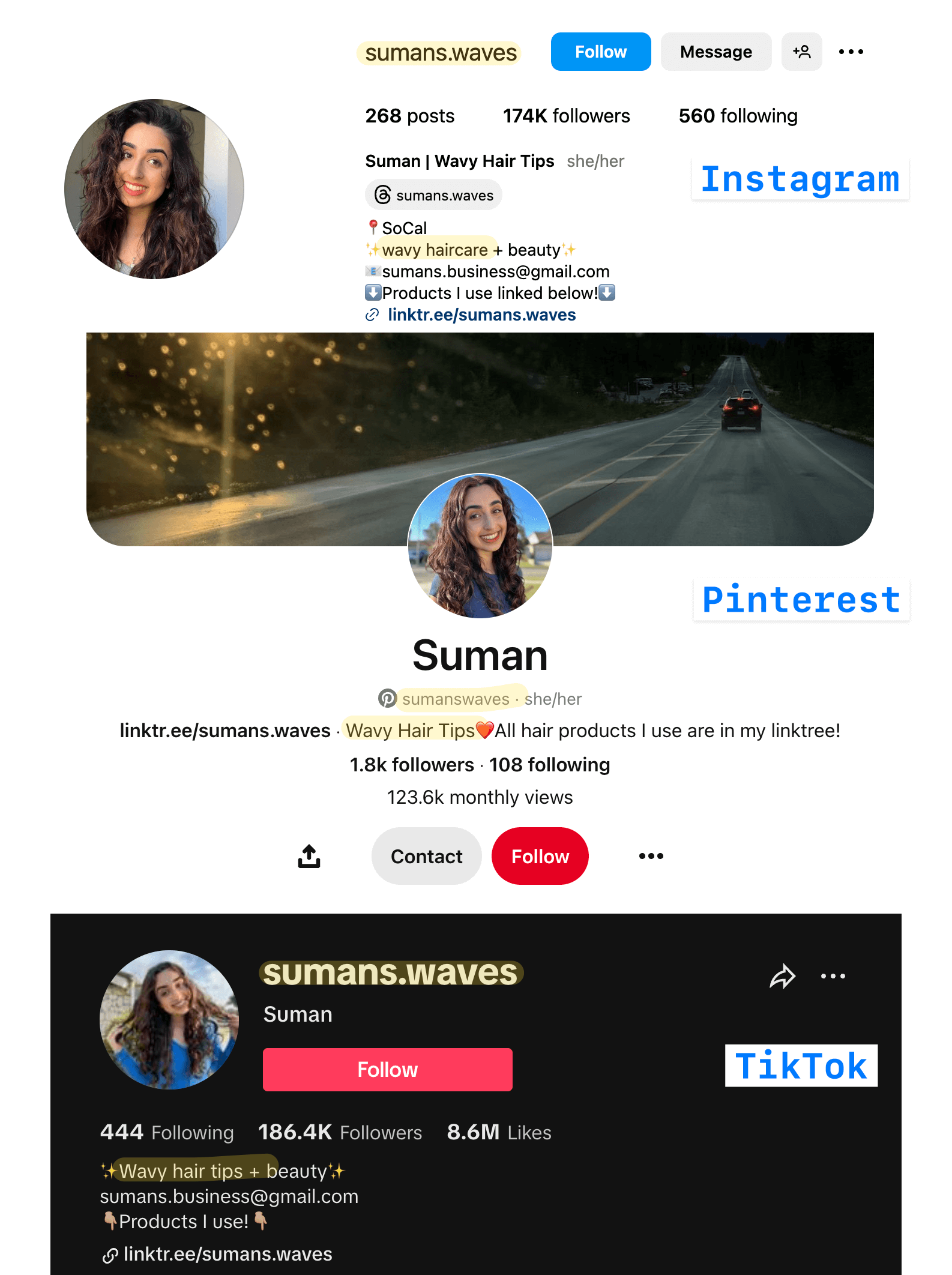
This consistency makes it super easy for Google to collate all of Suman’s profiles in search results and verify their legitimacy. When you search for “suman wavy hair” on Google, the top results are her social media channels across various networks.
2: Link to the same website, address, phone, and email across social media accounts
Use the same email, website, address, and phone number across all your social media profiles. Why? To help Google verify the legitimacy of your business.
In technical terms, accurate NAP (name, address, and phone number) is crucial for local SEO. If your customer support email address differs on Instagram from your website, Google might negatively impact your local search rankings. It looks for consistency and accuracy in your overall online presence.
Want to link to multiple websites? Instead of using buried links on social media, use Buffer’s Start Page to build a customized landing page for free in a few minutes. You can add your branding splash, link to multiple websites, and even track your link data.
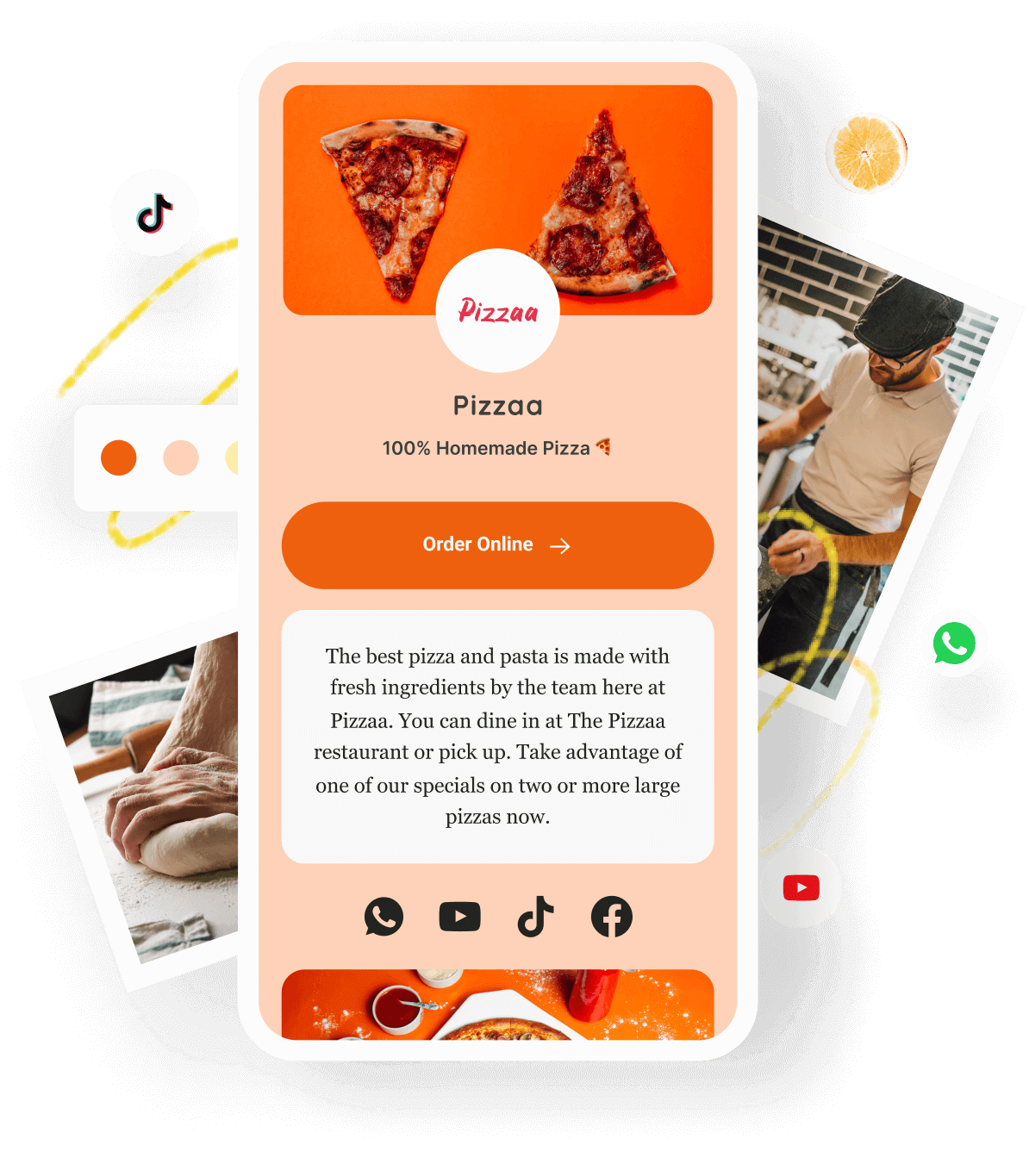
3: Incorporate relevant niche-related keywords
While your company name and consistent brand messaging are essential, you should also use niche-related relevant keywords in your social media bio to make your profile more search engine friendly.
Why is this important? Someone who doesn’t know your brand might still search for niche keywords on search engines and discover you. For example, the jewelry brand Cuff Copenhagen has “Unisex Jewelry Brand from Denmark” written in its Instagram bio, which is full of relevant keywords like “jewelry brand” and “jewelry brand from Denmark,” to name a few.

People don’t always search for branded keywords on social media. They might just search for “best jewelry brands from Denmark on Instagram” and check out the SERP’s top picks. Incorporating relevant keywords in your industry can help you become more discoverable in these types of queries.
Think: What keywords might my potential customers search for to find brands like mine?
Improving the visibility of your social media posts within social networks
The second facet of social SEO is having your individual social content appear at the top when people use the search bar within social media platforms. Here are five checklist items to make every social media post of yours SEO-friendly:
1: Add relevant keywords in your social media captions
Search engines within almost all social media platforms use captions to understand what your post is about. Creating relevant content isn’t enough. Use the right keywords to help social search engines gather info about your post. For example, this Instagram post by curly hair stylist and creator Jarely Jones hits all the right keywords for “diffusing techniques” in the caption.
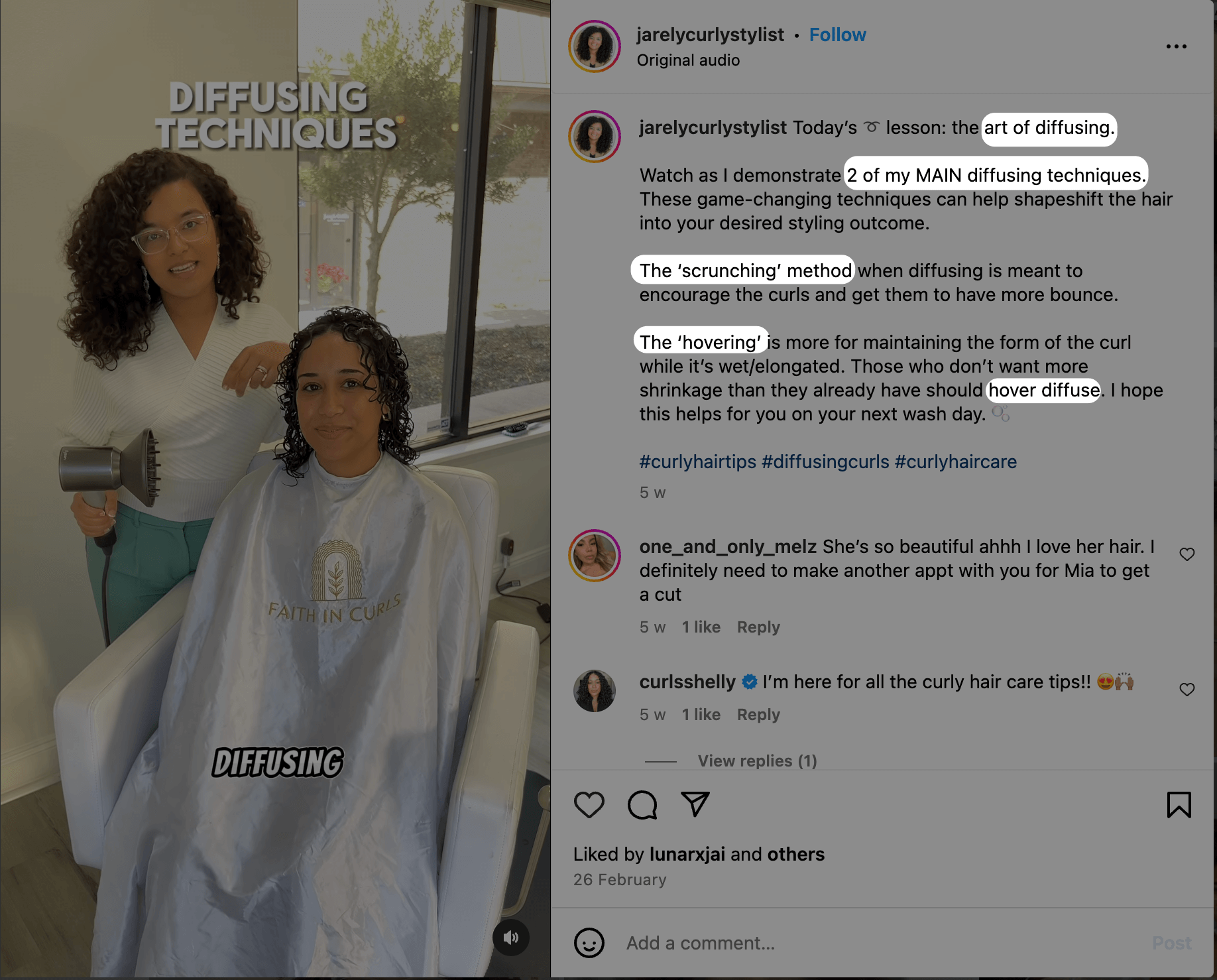
She also used related keywords like “hover diffuse” and “the scrunching method” so Instagram’s search engine can better fathom what her posts are about and maybe even display them at the top when adjacent keywords are searched for.
How to do this keyword research? You can find your target keywords by using traditional SEO tools like Answer the Public. It’ll help you find what questions your potential customers are searching for. You can also find some relevant keywords in TikTok’s Keyword Insights and Pinterest’s Trends Tool. Ultimately, the best way to find relevant keywords is to regularly listen to your audience and practice social listening by keeping an eye on the market.
⚠️ Remember: Like traditional SEO, keyword stuffing doesn’t work on social SEO. Use keywords naturally in your captions where they fit organically. Don’t jam them in just for optimization.
2: Use relevant hashtags in your social media posts or captions
Hashtags help categorize posts on social media. People might search for specific popular hashtags and using the right ones can help your posts appear at the top.
How many hashtags to use varies from social media network to network. Take Instagram hashtags: The platform recommends using three to five relevant hashtags.
Add a mix of both popular and niche hashtags. For example, Ian Evans, creator at tl;dv adds similar hashtags regarding social media marketing and organic social media to his LinkedIn posts.
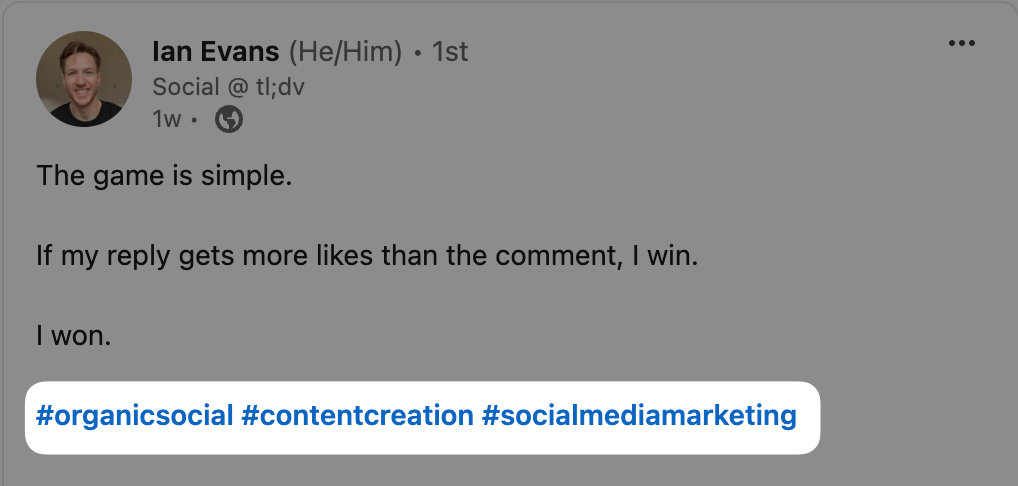
Hashtags can center around products, concepts, communities, holidays, locations, and even your brand. Use a hashtag generator to find relevant hashtags in your niche and industry. Then, use Buffer’s hashtag manager to store, save, and organize these hashtags so you don’t have to manually add them in your posts every time.

Most social sites’ search engines will be happy with three to five focused hashtags. Using more can also appear as spammy to your audience.
3: Add relevant hashtags to your video subtitles and images with overlay text
Social media platforms read the video subtitles and images and align them with your caption for SEO requirements. Simply adding subtitles to your YouTube videos or adding relevant text in images can help improve your rankings in social search. They also make your social media posts more accessible — a win-win.
Take this post by You Need A Budget (YNAB). It uses many holiday-centric keywords in the image — which makes it more friendly for Instagram SEO.
But this isn’t in a silo: Notice how YNAB also uses relevant keywords like “holiday money planner” and “Christmas shopping” in its caption and hashtags. All elements of your social media post should align toward one central keyword and multiple related keywords.
4: Include alt-text with every image
Alt-text or “alternative text” is a brief description of the image you’re uploading. All social media networks allow you to add this alt-text since it improves the accessibility of your posts. A bonus is that it can also boost your social SEO efforts. Social networks use alt-text to understand your image (and again, align it with your caption and hashtags for a holistic view).
On Twitter (now X), for example, you have 1,000 characters to add an alt-text to your image along with your tweets.

In the alt text, use an accurate and concise description of your post's topic. To make it even more SEO-friendly, add any relevant keywords.
5: Monitor trending topics in your niche and create content around it
Social media moves at whip speed. Social SEO content typically has a shorter shelf-life than traditional SEO content. Hop on trends and whip them up to be relevant to your niche and industry.
For example, Annie-Mai, a social media marketer, often uses trending memes in her social media posts.
The easiest way to embed trends in your social media posts is to use trending audio on TikTok and Instagram. These audio clips often have adjacent dance moves or post-style to go with them to match the trend’s vibe. It’s easy to shape them into something relevant to your niche.
Using trends might make the algorithm favor you, boosting your posts’ engagement and making them appear at the top when someone searches for relevant keywords. This is a classic example of how social media algorithms and social SEO work in tandem to give you the most brand awareness.
Using social SEO to boost your website traffic
Social SEO can act as a distribution channel for your site content. Here are two ways to do it:
1: Repurpose website content for social content
Repurposing your content regularly should be a non-negotiable part of your content strategy. We regularly repurpose our long-form content at Buffer for social media to boost social and website engagement.
For example, we published a LinkedIn carousel post about increasing Facebook followers, which is derived from a long-form post. We added the call-to-action to read the article in full to encourage our LinkedIn audience to visit our website.

You can practice repurposing similarly by breaking down content into bite-sized pieces for social media. Incorporate social SEO best practices in the previous section to improve its visibility and more & more of your potential customers will be redirected to your website.
2: Create shareable content on social media
Shareable content is anything that gets distributed among friends, reposted, or even saved in bookmarks. Creating more shareable social content ensures you boost your original post.
For example, if you repurposed an Instagram carousel from one of your content marketing long-form assets and made it highly shareable and saveable, you’ll boost its social rankings. Social shares and saves will supercharge your social signals — which might improve your rankings in SERP (for search engines like Bing) and backlinks (from various people sharing your original post due to its popularity on social media).
Shareable content is usually entertaining for platforms like Instagram and TikTok. For LinkedIn and Twitter (now X), people might share tweets on which they have additional thoughts or are relevant to their interests. Infographics also make for easily shareable content. Saveable content is tutorials, product lists, recommendations, and tactics.
Think: What would my audience want to share with friends or save for future reference?
High-quality content and consistent publishing is a prerequisite to social SEO
Social SEO isn't magic: It thrives on a social media calendar that publishes content regularly and high-quality content that’s helpful for your audience.
To make the most of social media’s search engine optimization, first focus on producing social content that your audience would love. Then, shift the spotlight on its distribution using the SEO techniques mentioned above. A holistic social media management solution like Buffer can help you do all this and more — for free. Try it today.
Getting Spotted on Instagram: How to Ace the Instagram SEO and Get Discovered in Instagram Search
Try Buffer for free
140,000+ small businesses like yours use Buffer to build their brand on social media every month
Get started nowRelated Articles

I spoke to leading B2B content marketers (an in-house content director, agency owners, top freelancers, and thought leaders) to find out what they think B2B brands can do to create good content in 2024.

Black Friday and Cyber Monday marketing guidance to help you stand out from the crowd — complete with tried-and-tested examples.

Over the past two years, Buffer’s Senior Growth Marketing Manager, Sophie, has run 25 A/B tests in Google Adwords. In this article, she shares her strategic approach to conducting successful marketing experiments, how to come up with new experiment ideas, and the lessons she’s learned along the way.